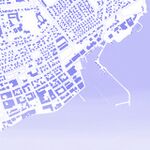Inscríbete y crea tu propia colección de obras y artículos
Ultra-Ruin
Ficha técnica
- Arquitectos:Marco Casagrande
- Project Manager: Nikita Wu
- Casagrande Laboratory team: Frank Chen, Yu-Chen Chiu
- Materiales: Mahogany, Zelkova, Camphor, Taiwan Cypress, bronze, steel, stone, brick
- Location: Yangming Mountain, Taipei, Taiwan
- Site: ruin of an abandoned farm house and surrounding terraced farms
- Interior space: 210 m2
- Terrace area: 520 m2
Descripción
Ultra-Ruin (completed 2013) is a wooden architectural organism that is growing from the ruins of an abandoned red brick farmhouse in the meeting place of terraced farms and jungle. The weak architecture follows the principles of Open Form and is improvised on the site based on instincts reacting on the presence of jungle, ruin and local knowledge.
The complex has a variety of multi-functional spaces and platforms that can be activated for different living functions and for meditation. The spatial continuity between interior and exterior spaces is flexible – also the inside is out and the jungle is in the house. The Ultra-Ruin is an architectural instrument played by nature including human. The main user is a private family, but the space is occasionally opened up for wider meetings.
Ultra-Ruin is more of an organic accident, than based on industrial control. Accident is greater than architectural control. Architectural control has been opened up in order to let nature to step in and human error to take place. In order to understand the dynamics of an accident one must be present. To be present is the key of all art.
Architecture is not an independent language and architecture is not talking alone. Architecture needs nature to become part of nature. Ultra-Ruin is a post-ruin condition, where human has come back to the house / ruin and share the same space with jungle.
The Ultra-Ruin has been developed in close and still ongoing dialog with the client since 2009. The first architectural reaction was to build a table around which we could talk. Then to build a shelter for this table. The rest of the Ultra-Ruin has grown up around this initial impact. We still keep talking and the Ultra-Ruin keeps growing as an open form.
The first model of the Ultra-Ruin was realized for the Victorial & Albert Museum in London, 2009. The now realized villa / ruin in Taiwan has grown out of this seed.
COMMEDIA DELL'ARCHITETTURA
Architecture gives the commands and architects listen. Actually nature gives the commands and architecture takes form. Architect is a design shaman that communicates with this reality. Design cannot replace reality, nature. Human control must be opened up in order to let nature step in. Architecture must be ruined. Ruin is when man-made has become part of nature.
To be present is the key of all art. Architect is a site-specific instrument through whom the great voice of architecture starts to resonate and find form. This great voice is weak and needs great presence, sacrifice and sensitivity to be heard. Architect is one of the sensitive beings to hear this voice and protect the sound. Architecture either is or it isn’t. It cannot be speculated. Architecture is a real reality.
“What really happened to Porcupine?”
“One day he came back from the Zone and became amazingly rich, amazingly rich. The next week he hanged himself.” – Stalker, Tarkovsky
People live in space and this connection can be art, a higher thing than what could be designed. Architecture is an accident, which is a higher thing than human control. In order to understand the accident and to let life run through it one must be present. To be present is the key of all art. This crack in human control is the acupuncture point through which the organism of architecture can grow. Biourbanism is the city of cracks. Architecture is a mediator between man and nature, connecting human nature with the rest of nature, reality. Architecture is the art of reality.
Planos
Archivo:Ultra-Ruin Plan Marco Casagrande.jpg Archivo:Ultra-Ruin Facade Marco Casagrande.jpg
Otras imágenes
Archivo:Ultra-Ruin jungle Casagrande.jpg Archivo:Ultra-Ruin roofs Casagrande.JPG Archivo:Ultra-Ruin moon in evening Casagrande.JPG Archivo:Ultra-Ruin dinner table by Marco Casagrande.jpeg Archivo:Ultra-Ruin entry Casagrande.JPG Archivo:Ultra-Ruin dinner table Casagrande.JPG Archivo:Ultra-Ruin Loft bath Casagrande.jpg Archivo:Ultra-Ruin loft deck Casagrande.JPG Archivo:Ultra-Ruin Moon Light.jpeg Archivo:Ultra-Ruin sauna and tower Casagrande.JPG Archivo:Ultra-ruin sauna and pool Casagrande.jpg Archivo:Marco Casagrande @ Ultra-Ruin.jpg
